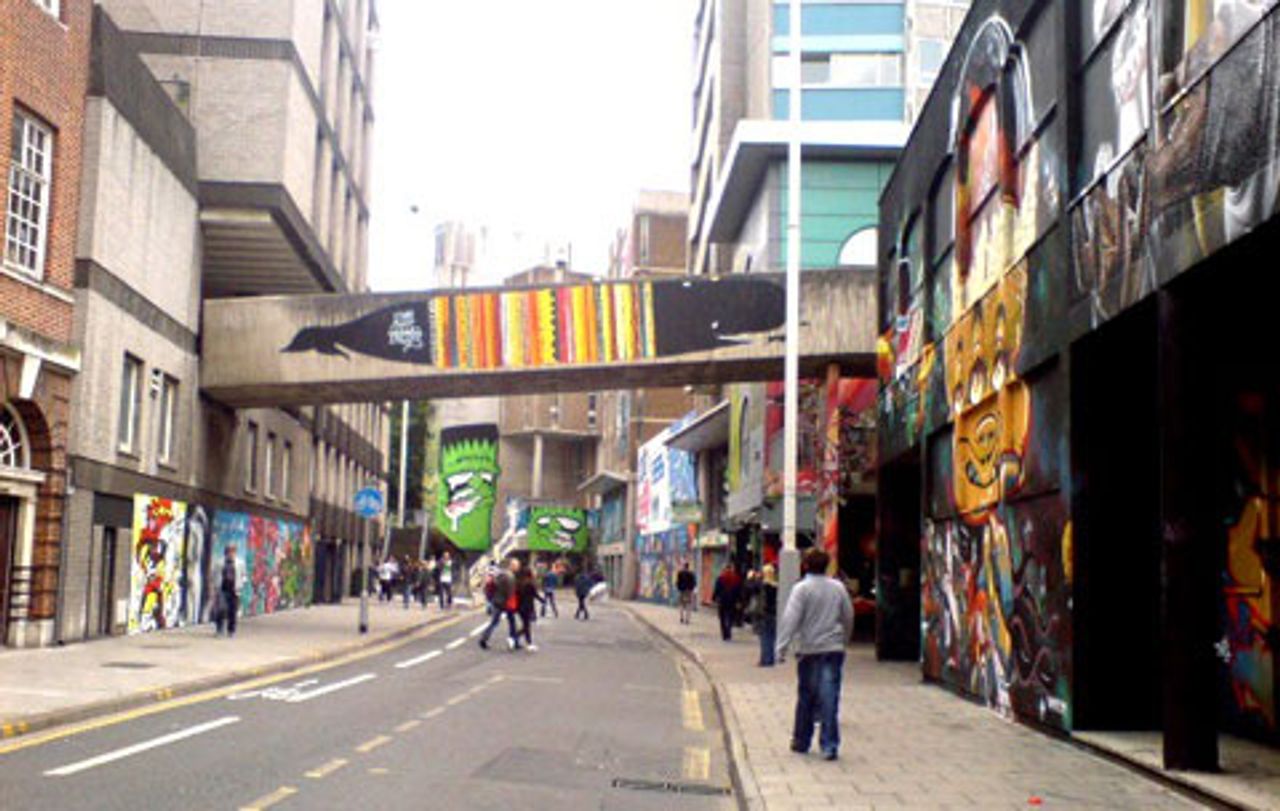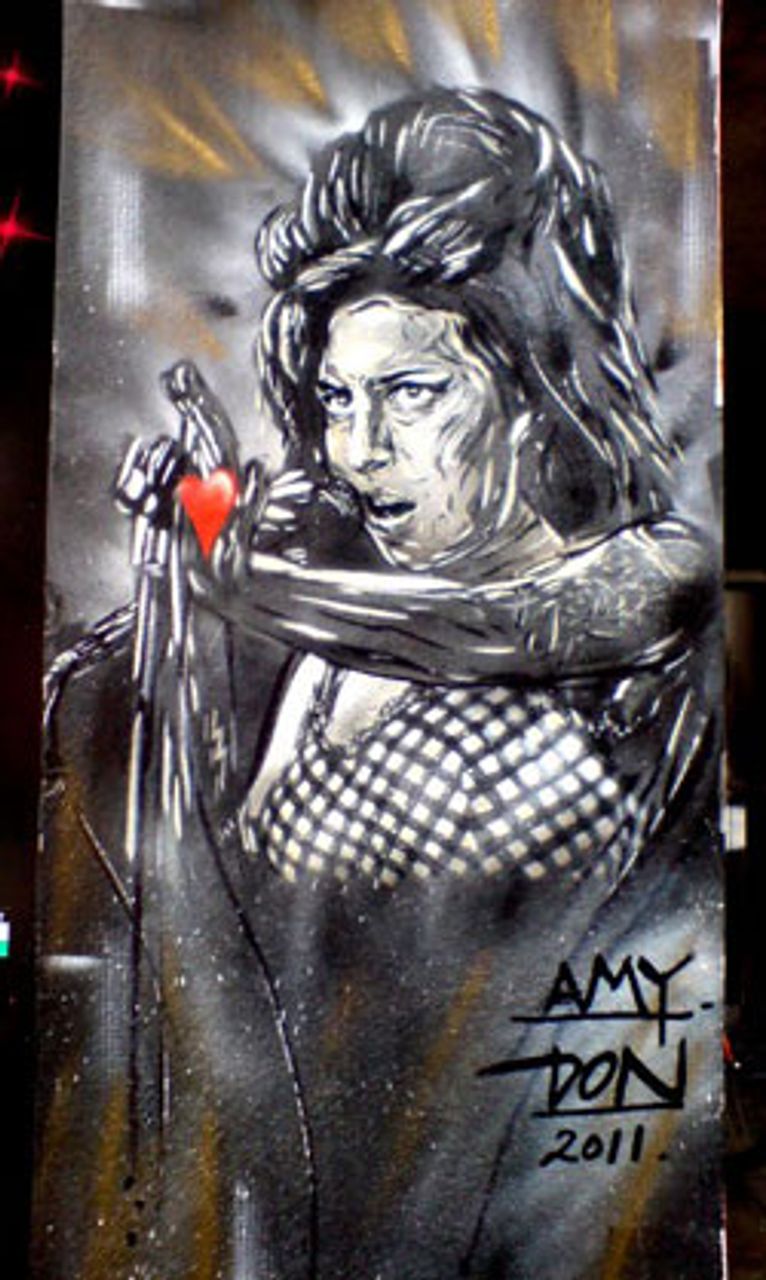 Mural
MuralOver seventy leading graffiti and street artists have been brought together in a project to paint ten of Bristol’s central multi-storey buildings in Nelson Street.
The project, organized by “See No Evil” in conjunction with the council and local businesses, has been called the biggest such art project in the UK. It comes two years after a major exhibition of the satirical work of local graffiti artist, Banksy. The city is hoping for a similar popular response to this project.
The Bristol Evening Post reported that the council had spent £80,000 on the project, hoping to emulate the success of the Banksy exhibition, which “had an estimated £15 million economic impact and kept many businesses going during that period.”
 Nelson Street
Nelson Street
Local building owners shared these hopes, agreeing to the painting of their premises. Scaffolding was provided, and public access to Nelson Street was closed for a week to allow the artists to paint the concrete slabs of decaying 1960s architecture. The exhibition was launched during a sold-out two-day event of live music and DJs.
 Amy Winehouse
Amy Winehouse“See No Evil” said they had spent nearly a year negotiating and planning this project, which they described as “the jewel in the crown of the city’s already buzzing art scene.” They announced that they had invited “some of the world’s most talented graffiti artists to bring their skills to the city.”
Despite such claims, this project is unlikely to have the same impact as the Banksy exhibition. The focus on commercial negotiations has exposed some of the artistic limitations here. The project suffers particularly from the lack of any united artistic theme.
It is debatable whether the exhibition has improved the appearance of Nelson Street. The graffiti are scattered randomly, with no articulated theme. From a small dedication to singer Amy Winehouse, to a huge mural of a pink wolf wearing trainers, the work reveals artists reflecting their own somewhat narrow personal interests, although some more interesting pieces do offer some reflection on social conditions.
An oasis fantasy scene by Xenz caught my attention. Detailed ivory weeds climb the pillars of one 1960s building, opening onto a scene of blue waters and high mountains that are in stark contrast with the drab grey canvas provided. The work is well integrated into the crumbling structure. Yet because of the lack of coherent theming, its impact is somewhat undermined by bright green cartoon Frankenstein heads to its left.
Other animation-type art was more successful. Tucked away in an obscure location up a side street, a comic-strip painting of a totem pole of monkeys offers a contemporary political take on the theme of “Speak/Hear/See No Evil.” One monkey sits with cash dangling from its mouth. Another, sat on its head, has banknotes stuffed into its ears. At the top a monkey with banknotes over its eyes is wearing pinstriped suit, holding a copy of the News of the World and carrying a briefcase labeled “bonuses expenses.”
 The Wolf
The WolfStreet art projects are nothing new. Such commercial projects have been used internationally with the same aim of regenerating crumbling areas, in events like the 2006 Red Bull project Outsides in Wuppertal, last year’s Super Mario Street art project in New York, and Amsterdam’s recent Stichting projects.
Street art and graffiti have been generally seen as challenging existing environments or mediums to display art conveying social subjects, unconstrained by commercial considerations. Such regeneration projects highlight the limitations of such a view. Bristol City Council placed an investment value of £80,000 on the Nelson Street project and anticipates much greater returns.
While such attempts to incorporate the medium continue, in other instances street artists face persecution. In July 2008 a group of South London graffiti artists were jailed for up to two years for defacing public property, even as their work was being championed by a New York gallery.
The strengths graffiti art has are its provocative nature and often political and social message. I have always found its appeal to lie in the dangerous and challenging location of the often skillfully produced art, along with some expression of political comment. There is little sense of that along Nelson Street. Street art sponsored by Bristol City Council and “See No Evil” tends to demonstrate that an exploiting society has given birth to an exploitive culture.
The internationally famous graffiti and street artists here for the most part give no sense of any appeal the form might have. They show rather its limitations. Provided with scaffolding, paints and projectors to trace images, and with political messages safely hidden away in side streets, they reflect a willing commercialisation of graffiti and street art. I wonder what might have been the results had they simply been given permission to use the street and then left free to reflect contemporary conditions in Bristol without support or constraint. Instead Nelson Street offers not much in the way of inspiration, charm or fascination, and little social message.
Fill out the form to be contacted by someone from the WSWS in your area about getting involved.
